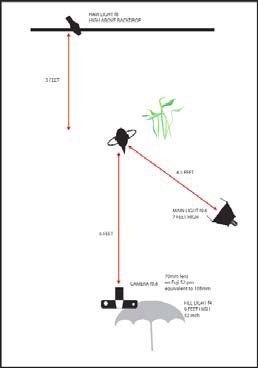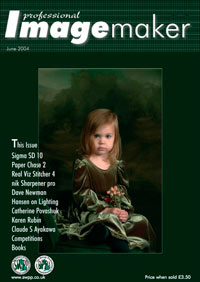articles/Portraiture/lowkeyportraiture-page4
Thoughts on low key portraiture - part 4 of 1 2 3 4 5 6 7
Published 01/06/2004

Vignetting Low Key
Vignetting has long been associated with the photographic image and was impossible to control with any degree of precision wit the simple optics initially available for photography. However it was the painters who started Vignetting in order to bring dominance to the faces of their sitters by surrounding them with darker tones. In low-key images Vignetting is usually a key element achieved by one or a combination of three methods each of which has a different effect,
Control the light
This further sub-divides. You can vignette the background lighting (shape of the pool of light not its strength). You can illuminate the backdrop evenly but have a vignette painted onto it. You can shape the light on the subject and cause it to fall off around the edges. Finally you can make combinations of some or all of these effects.
In camera
You can attach a gizmo to your lens. Many have been produced by equipment suppliers and by the photographers themselves. Black stocking have figured (both in front of and on the lens), chopped up and stretched across lens hoods, graduated density filters have been produced. All of these devices have the common feature of affecting the entire scene, that is the darkening encroaches on the sitter's head, feet, arms and shoulders. While superb images have been produced with these lens devices we all sometimes find ourselves wishing that the vignette was a little fatter, more elongated, squarer etc.

In Photoshop
This topic was covered in a previous issue of professional Imagemaker. In essence you make an adjustment layer over the whole image and use the adjoining, default mask to control where the darkening takes place. This can be shaped to include only those bits of the image that you wish to darken and Gaussian blurring the mask controls the boundaries where the Vignetting meets the subject. This method is second best to controlling the scene lighting but can also be used to modify it.
The PropsLow Key
The props for any studio session are vital. Effectively, what you are trying to do is recreate the best location you have found on your travels, indoors, in your studio, with full lighting control as a bonus. Whilst you can purchase props from a number of the excellent companies that deal in these products, you could also keep your eyes open at the local auction houses and clearance sales. You can pick up an old Chippendale and a couple of old oil paintings for a song and chuck them if you get bored! At the recent Dave Newman seminar we had a bit of discussion about your props and backgrounds getting stale with over usage. Dave had two takes on this as he has had clients asking why the fourth child was photographed against a new back drop when they wanted all the pictures to be the same- you can't win! Tom Lee has hit on the idea of creating a backdrop on his Epson 7600 and gluing the pieces together. That way you can ring the changes faster and it look as if it will be relatively inexpensive - we will keep you posted! For period low-key, flowers are pretty vital and providing you are going to have them out of focus you can make do with silk blooms rather than fresh. You can expect to pay about £2 for a rose and up to £40 for a small bush or tree. You could do worse than popping along to your local community college who are almost certain to have flower arranging classes, and get some help in setting them out. Your other option is to do a deal with the local florist and provide them with a nice framed canvas as quid pro quo - that way you get free advertising as well!
Broken down arches, dry stone walls and the like are a little trickier and you are going to have to pay out for those. A set of girders is going to set you back a few thousand pounds. For iron gates you might be best having a chat with your local blacksmith. Swings (that work) require good engineering if you are to avoid injury claims so thing hard about safety before you expose your sitters.
By way of example we reproduce Tom Lee's image of Patrick, below left. The backdrop is a hand painted one from Photo Friend. Tom's lighting diagram is shown below. The final image was produced off the Ilford Studio system onto Ilford Studio canvas and then given two coats of DCP Giclee varnish.
Please Note:
There is more than one page for this Article.
You are currently on page 4
- Thoughts on low key portraiture page 1
- Thoughts on low key portraiture page 2
- Thoughts on low key portraiture page 3
- Thoughts on low key portraiture page 4
- Thoughts on low key portraiture page 5
- Thoughts on low key portraiture page 6
- Thoughts on low key portraiture page 7
1st Published 01/06/2004
last update 09/12/2022 14:56:11
More Portraiture Articles
There are 0 days to get ready for The Society of Photographers Convention and Trade Show at The Novotel London West, Hammersmith ...
which starts on Wednesday 15th January 2025





